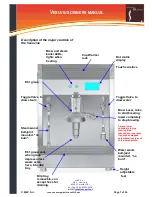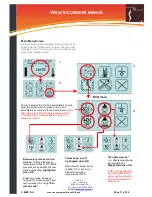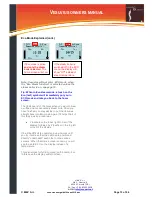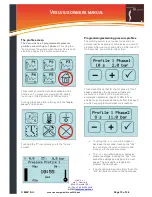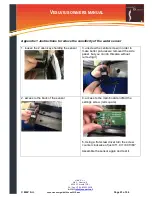
M&V S.r.l.
Via L. Guerra, 9
80040 Cercola (NA)
Ph./Fax +39 0815552428
e-mail:
© M&V S.r.l.
vesuvius userguide10 June 2015.doc
Page 17 of 24
Information Technology Solutions
V
ESUVIUS OWNERS MANUAL
Profile Advice (cont)
Phase 2 and beyond - The maximum or
rising pressure phases
You can reach maximum brew pressure any way
you want. A rise in stages from 2 bar to 5 bar and
from 5 bar to 10 bar, or a single rise to 10 bar. It is
up to you to experiment.
You may want higher pump acceleration and a
faster response, moderating the pressure rise by
having two rising stages. Or you may keep the
acceleration at the factory settings and use 2 stages
for a very soft and gentle rise to full pressure. We
have had good results with a single rise to maximum
pressure, but a 2 phase rise may not give benefits
for some coffees/temperatures.
Pressures over 11.5 bar are not recommended, as
the results do not improve beyond this point. The
E61 group has a maximum limit of pressure based
on the Vent release valve spring tension. For most
E61 groups this is around 12.5-13 bar.
Note: the Vesuvius high pressure PTFE tubing and
fittings are rated for 25 bar pressure, well beyond
the capabilities of the pump.
Later phases after maximum pressure
Normally during the extraction process, the pour
starts to blonde and often it loses integrity. We feel
high pressure continually applied causes this and
progressively lowering the pressure as the pour
progresses will result in a better sweeter, more
rounded shot with improved body. This is probably
the reason for the good shots that many spring
lever machines produce, but we have a level of
repeatable control, well beyond that of any lever
machine.
How much you lower the pressure and how fast is
influenced by your taste, the coffee used and the
grinder you have. You need to experiment and share
information with other owners .
How the Vesuvius Controls pressure
The Vesuvius uses pressure transducer, commercial
valve system and PID algorithm to control pump
pressure. Although not perfect, it is better than a
simple on off control, which would be unable to
manage rapidly changing pressures.
You may notice brew pressures can overshoot the
set point sometimes, this mainly happens with
increasing pressures. High pump accelerations
increase this tendency as do different coffees and
grinds.
As dynamic pressures approach the
static pressure potential in the system, pressure
changes happen very rapidly
. The PID system
reacts very fast, but has a finite reaction time. If PID
settings are made very aggressive to damp this
response it can cause hunting lower down the
pressure ranges as the pressure falls.
These pressure overshoots are brief and have a
minimal effect on the shot, as it's mainly static
pressure showing rather than dynamic pressure.
The higher the pressures you ramp to e.g. 11 or 12
bar, or the faster the pump acceleration, the more
you might notice this.
You can fine tune the pump PID settings further, but
it's recommended to use the factory settings until
you become familiar with the machines operation.
Grinders.
The Vesuvius is not a cheap machine and the
temptation might be to use a grinder unsuitable for
the machine. To get the
most benefit
from this
advanced machine use a grinder costing from
approximately 25-50% of the machines value. To
give a real world example
, a grinder such as the
Mazzer Super Jolly or similar class grinder
would be the absolute minimum required
and
better results will be obtained with more expensive
grinders.
The Vesuvius is able to use a grind much finer than
standard espresso machines and the less expensive
grinders tend not to grind as well at the finer
settings.
Coffee
To do the Vesuvius any justice at all, coffee must be
fresh. You should know the roast date of the coffee
and only use quality coffee from good roasters.
Ideally the coffee should rest for at least 5 days from
the roast date before being used, Often even
longer. Use the time recommended by your roaster
for resting any specific coffee before use.





